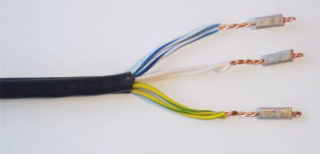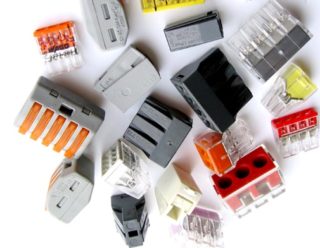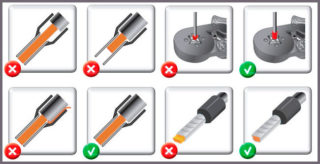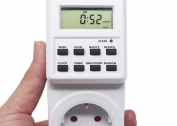Every homeowner, car owner, and garage owner will sooner or later have a connection issue. There are several ways, the performance and durability of the equipment will depend on the chosen one. One of the simplest reliable methods is wire crimping.
The essence of the method and advantages
Crimp for wires is a way to connect them using special sleeves. Visually, they resemble ordinary tubes. The main task is to play the role of the connecting mechanism.
The conductors of the wires that need to be connected are turned all the way on both sides of the sleeve and crimped with special press pliers. The result is a reliable and durable electrical unit. The tube must be compressed in several places, depending on the cross-section of the switched conductors and the length of the cores. The connected sleeve with veins is also subject to deformation. Due to squeezing, the cores are coupled, which ensures reliable electrical contact. In conclusion, it is necessary to insulate the junction.
The crimping method is most in demand in such cases:
- if necessary, connect wires with a large cross-sectional area;
- for connecting stranded conductors;
- if there is a need to connect wires in power lines with high current load.
The advantages of the method:
- The tool designed to crimp the sleeves is used without electricity. In rooms where there is no voltage - crimping is the only way to connect.
- Such a connection does not require maintenance during the entire operational period.
- Using sleeves, you can connect conductors made of different metals. One of the most common problems faced by electricians is the commutation of copper and aluminum conductors.
- The connection quality is at a high level, the amount of time spent is minimal.
- A special crimping tool allows you to connect the cores, even in very limited spaces, for example, in a box or socket box.
Even a person without experience and skills in this area can squeeze a sleeve, unlike other methods of connection. For example, when soldering, you need to be able to use a soldering iron and solder.
What is the connection process
Before starting work, you need to purchase couplings suitable for the diameter of the wire. This indicator should exceed exactly 2 times the diameter together with the insulating layer.
There are two types of couplings - simple and with complicated insulation. The former have a single layer of plastic, the latter equipped with a layer of heat shrink on the surface and inside with a layer of glue with sealant.
It is worth taking a responsible approach to choosing a tool - press pliers. The best option is a modification equipped with a ratchet for fixing, which greatly simplifies the process of working with uninsulated and insulated conductors.
Work begins with cutting the wire with wire cutters. Further, it is important to clear them of insulation by a length of 0.5 of the sleeve length. If several wires are connected on one side, they are twisted first. Then put on the sleeve and carefully healed with ticks. If heat shrinkage was included in the kit, they are put on until crimped.
One side of the tick is equipped with an oval sponge, and the other with the same sponges, only of large sizes. The smaller side is for clamping the insulation of the wire in the sleeve, and the second is for fixing the metal sleeve.
For a reliable connection, the pliers crimp the sleeve first on one side and then on the other. Next, heat shrink is mounted and processed by fire from one side to the other. If the wires are connected on one side, the heat shrink is worn in advance.
Other connection methods, their advantages and disadvantages
The most common method after crimping wires is soldering. In electronics, it still occupies a leading position, since it has high mechanical strength. Of the disadvantages, it is worth noting that in a humid environment and places with large temperature differences, this method of connection will not work.
Another known method is twisting. The main advantage of the method is its implementation - a minimal set of tools is required. When connected, the conductors remain intact. To twist the wires, you only need to clean their small sections of the insulating layer. Dismantling the connection should also not cause questions. The only difficulty that may arise at the stage of work is a small contact area, as well as low reliability of the connection.
Crimp wire connector combines the advantages of all methods.
Common wire crimping errors
Despite the fact that it is easy to crimp the wires, people make typical mistakes during installation.
- The use of a sleeve, the dimensions of which are the same or smaller than the cross-section of the wire. In this case, it will be necessary to cut a part of the wire, which will adversely affect the durability and reliability of the connection. This also leads to a decrease in the resistance and throughput of the injuring section of the circuit.
- Pressure testing of the sleeve using tools not intended for this. To ensure a high-quality connection, special mites should be used, other tools will not be able to provide the desired effect. Pliers and a hammer damage the structure of the lugs, which again negatively affects the durability and performance of the wire.
- Another common mistake in crimping wires is cutting the sleeve to save money. In such sections of the chain after increased resistance, deformation of the geometry of the tips. The strength and reliability of the connection is poor.
- The use of excessively large sleeves. This approach is also not crowned with success. Even slight bending will immediately reduce the bond strength.
In conclusion, it is worth mentioning the observance of personal safety techniques. Live electrical appliances and wires are a potential threat not only to human health, but also to human life.







